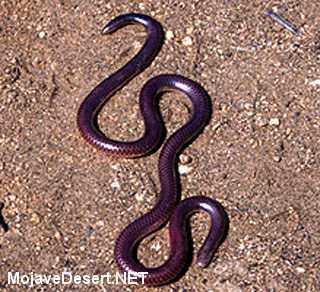--
Western Blind Snake
Leptotyphlops humilisFamily: Leptotyphlopidae Order: Squamata Class: Reptilia
DISTRIBUTION, ABUNDANCE, AND SEASONALITY
The western blind snake is widely distributed in southern California from the coast to the
eastern border at elevations up to 1515 m (5000 ft). It seldom occurs in strictly sandy areas,
alluvial flats or dry lakes. Little is known about abundance. A wide variety of habitats at lower
elevations is occupied where conditions are suitable for burrowing, or hiding under surface
objects and in crevices (Klauber 1940, Brattstrom 1953, Brattstrom and Schwenkmeyer 1951,
Stebbins 1954, 1972).
SPECIFIC HABITAT REQUIREMENTS
Feeding: This snake eats ants, termites, their eggs, larvae and other soft-bodied insects
(Stebbins 1954).
Cover: This snake burrows, spending most of its time underground. It has also been
taken under objects such as logs, rocks and among the roots of shrubs. They have also been
taken under granite flakes (Stebbins 1954).
Reproduction: No data.
Water: The western blind snake seems to prefer moister habitats but is found in very arid
environments, so permanent water is probably not required (Stebbins 1954).
Pattern: This species prefers moist areas. In canyons, stony and sandy deserts, rocky
slopes and boulder piles, and scrub.
SPECIES LIFE HISTORY
Activity Patterns: This snake appears on the surface at night but may be active
underground at other times. Greatest seasonal activity occurs from April to August (Stebbins
1954).
Seasonal Movements/Migration: No data.
Home Range: No data.
Territory: No data.
Reproduction: Little is known about reproduction. An average of 4 eggs (range 2-6) is laid
in late summer (Klauber 1940, Stebbins 1954).
Niche: There is one record of this snake preyed upon by a coyote (Stebbins 1954). It is
probably eaten by most avian and mammalian predators when encountered. Nothing is
available about diseases parasites or competitors.
Also See:
Joshua Tree National Park Wildlife
Snakes Southwestern Blind Snake Leptotyphlops humilis humilis. Moist areas in canyons, rocky slopes and boulder piles, and among the roots of shrubs; ...
Death Valley Snakes
Snakes Sharing the order Squamata with lizards, snakes are a legless scaly elongate reptile; some are venomous. Western Blind Snake Lepotyphus humilis ...
California Department of Fish and Game. California Interagency Wildlife Task Group.

Western Blind Snake
Photo by Chris Brown

Western Blind Snake
Photo by Chris Brown

Western Blind Snake
Additional information:
Size: 7.2-13.0 in (18-33 cm)
Distinguishing characters: A thin cylindrical species with no neck constriction; blunt head and tail; purplish, brown or pink dorsum with silvery sheen; light venter; no enlarged ventral scutes; eyes vestigial, appearing as dark spot beneath head scales; spinelike terminal scale on tail tip.
Juveniles: Similar to adults, except lighter in color.
Dimorphism: None
Similar species: Anniella pulchra: Has eyelids; black dorsal striping and black tail tip.
Additional notes:
Difficult to hold since they will squeeze out of hands. Excretes watery fluid that has a musky odor.
